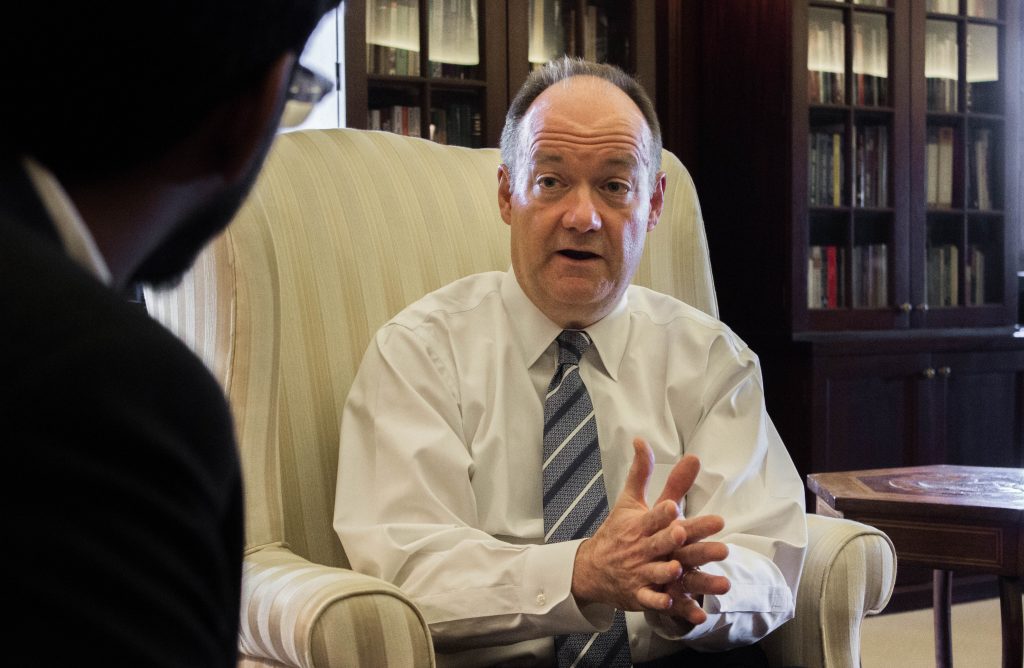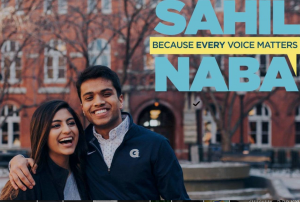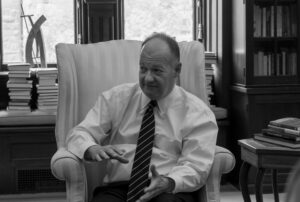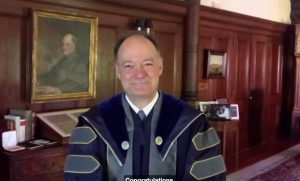On Feb. 18, Editor-in-Chief Daniel Varghese sat down with President John DeGioia for a conversation on a variety of campus issues. Here are some of the highlights of their conversation.

Maggie Murtha
On student activism
Daniel Varghese: I wanted to talk a little about the ‘Built on 272’ protests. At the end of that process, the committee that you created to deal with the issue, the historical legacy committee, came up with basically what they were going to do.
President DeGioia: Well they’re still at work. … We knew when we were doing that renovation that there was a part of our history that were were going to need to engage. And so it was in that context I spent several months in consultation with folks trying to determine the most appropriate structure for doing that and that was when we made the decision to create the working group on Slavery, Memory, and Reconciliation. I had contemplated simply changing the names myself, but I actually didn’t feel that that was the most appropriate way for me to behave as a leader. So when I charged that group in last August and early September, described to it what its responsibilities would be, even the title was very intentional–Slavery, Memory, and Reconciliation, because there’s a lot about the history that has been known and well-chronicled, and taught here in many different ways over the last generation. But what we knew was, it wasn’t known, so we needed to come up with the most appropriate framework for us to engage those questions. And then the working group went about its work.
And then mid-November, a number of things were happening on other campuses, and our students who visited, I brought them into the office that morning, and I just said what’s on your mind at this point? And a couple of them were actually on the working group, so we had that benefit. And they just said “we understand why you didn’t think it was appropriate for you to make the decision,” I think that was appreciated, “but we now think enough work has gone into this that taking the names off is an appropriate response.” So I said, well, again, for me to do that now, in this moment, would be no different than for me simply just to make the decision, it’s just under a different set of circumstances. I will convene the working group, and share with them your perspective. So I did, and I think the working group then responded that day.
DV: The thing I wanted to ask you about was all the smaller initiatives that were part of the other things they talked about, along with changing the names, including the grants.
DeGioia: So that’s where the committee’s still at work. I’d have to ask my colleagues where we are on that. What I would say is, though, an important thing when I charged the working group in September and then when I met with them again in mid-November, I said to them, listen, I told you you didn’t have to complete all your work wrapped up in a single package. If you were prepared to make recommendations and decisions at any time, you should feel comfortable making those recommendations.
DV: You’ve had a long history with Georgetown, as a student, as a professor, as an administrator, and now as the President. How have you seen Georgetown’s relationship with activism evolve over time?
DeGioia: I would say, if I were to give you the arc of my years here, there have always been passionate supporters around important issues, as long as I’ve been here. But I would say that it was a little quieter; I would say from when I was a student I could probably name the protests and demonstrations that might have occurred in that period. In the next decade while I was a graduate student and just getting started in my administrative work, it was still pretty quiet. That period from the mid-70s to the mid-80s was just not as intense. The last 30 years, I’d say it’s been pretty consistent, I haven’t seen waves. I think what we’ve tried to do is provide a context where we can have the most robust exchange of ideas and opinions, and ensure that this is a place where you feel protected in being able to do that. And so it’s gone through a few iterations, but our policy on speech and expression and the committee that’s been responsible for oversight of that over 30 years kind of provides help and interpretation. Because there are words on a paper, but then there’s a life lived here in this community, and often times you need to understand the context and the intent to be able to know how best to respond in any particular moment. I think we have a very good track record of supporting the widest range of speech and expression that there is.
DV: Do you think there’s any reason why particularly Georgetown has that [history of activism]?
DeGioia: There are a few things that sort of strike me. One is our location. It’s hard to avoid the most important issues of the day here, they’re happening all around, and they’re being discussed and they’re lived, and it’s hard not to have an opinion. I think our faculty are also keenly attuned, no matter what their discipline, they know other stuff is going on, and they’re helping to facilitate, foster, encourage, and open discourse.
I do think our Catholic and Jesuit identity contributes to it, in the sense that, you know, we’ve been wrestling with the question for more than 40 years. In 1973, the leader of the Jesuits, Father Pedro Arrupe basically sort of redefined what it meant for us to be a Jesuit institution. And part of that redefinition was, how responsive were we to the needs of justice in the world? I’m not sure there are as many institutions that that is so explicitly part of how we try to understand the nature of our engagement in the world. It certainly wasn’t the case when I arrived as a freshman, but the notion that at the core of our identity as an institution we would be wrestling with these kinds of questions, that’s evolved over the course of four decades. And Father Arrupe launched all that, and then Father Kolvenbach and now Father Nikolas, the three leaders of the Jesuits since the mid-1960s, have sustained that kind of momentum.
So I think there’s a part of that too, that would explain it, but I also think when you take the combination of the talent that we have here, you wouldn’t be here if you didn’t have a certain kind of facility with self-expression, it’s just, you couldn’t be here. You had to work that out in the fourth grade and develop that all the way through. You’ve been at this for a while, so there’s a certain level of talent when combined with the community that kind of enables it, that I think explains why we have a little more conversation around here than most.
On college affordability
DV: So one of the things that I know that you’re pretty passionate about is that offer of 100 percent need-blind [admissions]. I wanted to talk to you about this specifically because it is an election season, and one of the things that has come up, particularly from the Democratic side, is a conversation about higher education and tuition costs, and that’s definitely something that’s always on the mind of students. And about your role on the American Council on Education and 568.
DeGioia: The group that you’re referring to is called 568, and that is a reference to a line in the Higher Ed Reauthorization Act of several Higher Ed Reauthorization Acts ago, and we just were renewed last year to continue our work as a group. And need-blind, full need, those are our commitments. We made a decision in 1978 to be need-blind, full need. Being need-blind, it’s nice. It’s a good, solid moral position that basically says that we don’t believe your ability to pay is a relevant factor in our decision to admit you. OK. But once you’re in, what happens? But that’s where meeting full need, that’s our deepest commitment that we make as an institution. We’ve been making this now for 38 years, and really it’s at the heart.
In 1992, we were in a recession, and the president asked me to chair an effort to reevaluate our commitment to this, and I think most people felt that we would step away, and the recommendation coming from our working group was, we needed to deepen our commitment. And so now for these roughly 23 years, 24 years we’ve sustained our commitment. I’m very proud of that because I think it reflects very well on the deepest values that this institution has.
Why are we in this mess as a country? Because right now, we are 14th in the world in the number of 25-30 year olds who have a two-year degree or higher. We were last number one in 1992. There are real challenges in all sectors, so I’ll focus on two categories, the publics and the privates.
So public education in the United States is about 80 percent of higher education, private is about 20. We, as a high-cost private, we’re a very small sliver, there are probably 40 of us, and in that group we’ve been fortunate to compete in the roughly around top 20 or so. If you look at what is going on in both sectors you’ll see different dynamics but both problematic.
So in the public side, typically we look to our states. So we’d look to Nebraska to cover the cost of the University of Nebraska, at the state level with state taxes, and citizens of Kentucky would cover UK. In 1975 the average was roughly two-thirds of all expenditures at the state institutions were covered by state money. Today, it’s about a third. So it’s been cut that dramatically. What’s even more pernicious is the state flagships – take a school like the University of Virginia. Right now, the University of Virginia probably receives no more than eight percent of its budget from the state. University of Michigan is probably somewhere between 11 and 13, University of California, where you have the greatest public institutions the world has ever seen, you’re seeing that the numbers go down into the low teens, at best, for the UC schools. So what we have abandoned is a commitment to the education of our young people as a public good for which we are all responsible. So on the public side, where you see a lot of the complaints about high tuition going up is that as state support is going down, tuition dollars are going up, and that’s just what it is.
There are two levers that people have. One lever is to increase tuition; the other is to increase the number of out of state students who are going to pay the same price they would go if they went to a private institution. So UVA is capped. They can only have 30 percent out of state at the University of Virginia, by their legislature. If they could take it higher, they probably would. Their president was here for one of our conversations last fall and if they had the flexibility… let me put it another way. I think if they had the flexibility they would have no choice but to increase the number of out of state students, and you’ve seen that, for example, at the University of Michigan, where you have an even higher number. So on the public side it’s really a decline in state support that has driven increases in cost to the students.
On the private side, there really are two different kinds of worlds. There’s the world that Georgetown is in, which is a bit of an arms race, for talent, for opportunities, for resources, and then there’s everybody else who’s really trying to sustain a mission at a time where the average tuition discount rate is 48 cents on the dollar, which is the highest it’s ever been in history. What that means is, if you look at any of the small colleges, or even some of the universities, they’ll have a price that looks very high. They’ll know that no one’s paying that price. They’re all paying half that price. Or on average, paying half that price. Now some will be paying zero and some will be paying the full cost, but the average is 48 cents on the dollar. And this is an unsustainable model, and we don’t really have a strategy for addressing this at this point in time. There’s some institutions where the tuition discount rate is in the 70s, 70 percent, and you sort of ask yourself, well why are you doing that? Why don’t you just reduce the cost and see what happens? Right now, it’s too risky for them to get out of the current logic.
And then we have what’s at stake in the President’s plan and then in Secretary Clinton and Senator Sanders’ work has been the appropriate focus on the community college, because it is the entry point for so many people. The percentage of students in our country who work full time, it would shock you what it is. In four year programs in publics, I think like 40 percent work full-time. It’s an enormous commitment that people are making, the age range is far greater that anybody would imagine.
What we do here is kind of unusual in the higher-ed scheme, and I think what the President and what the candidates have been trying to figure out is, let me give you a few more statistics, and all of this comes out at Georgetown. We have a center here on Education and the Workforce, which is the leading source of study in our country on this. But just a couple of things: the average income if you have a four-year degree is a million dollars more over a lifetime than if you don’t. Number two: jobs. Tony Carnavale, who runs the Center, estimated that we would probably be around five million jobs short, meaning that there are five million jobs that require post-secondary education that we don’t have graduates for those jobs. And that conversation with colleagues from LinkedIn, this is just another anecdote, but a data point, they estimated that they have four and half million open jobs on LinkedIn. I haven’t asked Tony to comment on that, but it’s pretty close. He’s estimated in the next decade, we will create 11 million jobs. Some of those are replacements for retirees, but some of them are brand new jobs that require post-secondary education, and we won’t have graduates for that. So at a time when we need more graduates than ever before, to fill jobs to ensure the flourishing of our nation, we are underinvesting in higher education. It’s unconscionable. This is a time when we need to be doing evermore to provide for the opportunities for our students.
On science at Georgetown
DV: And then, so the last major thing that I really wanted to talk to you about is sort of on the importance of science in our modern life. You know, technology is everywhere and it is only going to become more of a part of our lives. One of the things that Georgetown has [is a reputation] of being is very anti-science. I wanted to get your reflections on that and your opinion about what I’ve heard from [the SFS] that a science requirement is coming.
DeGioia: The hardest thing to happen at a university is curricular change. It’s one of our strengths and it’s one of our challenges. And this has been on the agenda for some time. Two markers in this last period would be STIA and then Georgetown Environment Initiative, but I’d also say Regents Hall is a piece of the story as well. We began trying to pull this community together around just what you’re talking about. I would say somewhere within this last 20-year period, so you’re at an important point, it could be an inflection point, but it is part of the conversation that has been ongoing for some time.
The way I used to describe it is we need to be stronger in science. And people would say “but Georgetown is not a science school.” No, but we are Georgetown, and what you would expect of us, if you were to send your child here, is that for us to be able to provide a Georgetown experience, we have to be stronger in science. And that has been the puzzle we’ve been trying to wrestle with. The kind of funny way we would talk about it is, we weren’t trying to compete with MIT or Caltech, but we wanted to make sure that when you graduated you could read the Tuesday section of the New York Times on science, and [understand] the importance that science plays in every dimension of our life.
So we have seeded lots of different efforts over the last 20 years, which include the launch of STIA, which has been fantastic, and supporting some faculty in SFS, supporting the work in science in the public interest that Francis Slakey and others have been a part of. The Georgetown Environment Initiative, that’s another that is important for us. We are hopeful that that will be a galvanizing for us to strengthen science in a Georgetown way, by putting science in conversation with policy, law, economics, philosophy, and ensure that we’re bringing a new kind of perspective to the discussions regarding sustainability.
Janet Mann, our Vice Provost for Research, has been an advocate in this regard for some time. The voices are there. I believe that as we move into this, we’re bringing closure to a campaign, and campaigns are often galvanizing catalysts for your next set of priorities. And this past campaign, the Environment Initiative, was an important transformative opportunity for us, and we were successful in that one. We raised a million dollars plus for that initiative and that’s a good start but I expect you’re going to see even more as we get ready for the next wave of new work.
DV: To follow up on that, it seems like, from what you’re saying, that most of the professors and the faculty here are all in line with this. How do you deal with the fact that a lot of students aren’t, that people come to Georgetown because they don’t have to do science, and that the number of students who take science classes is so low?
DeGioia: I attribute that to the strength of the other classes – people want to be in those humanities and those social classes so much that they’re willing to sacrifice. But seriously, my sense is we tried a few things over the years. In the mid-90s we had a gift from a donor who enabled us to try to create very special classes in science. It was fantastic experience. These were kind of cutting-edge, we might even take them for granted now, but they were the first new-age, new-wave of kind of pedagogy. My recollection was Sony gave us money to design new kinds of classroom experience which were more experiential, more technology enhanced. What I would say is we may have caught up to that with the rest of the curriculum, but they were at the leading edge of this.
I only bring that up to say we know that in the curriculum we really compete for your attention and so science has to be every bit as good. And my sense is that we also have to make it clear what we think you need to be prepared to do when you leave here, and science has to be a bit more important than it is right now. I don’t know whether we are unusual among our peers, in the sense that places that are historically known as exceptional in social sciences and humanities might struggle with this a little more because there are some places that are so strong in science. What we want to make sure of is that you leave here with the same level of confidence in your science literacy as you would in your social science and humanities.





